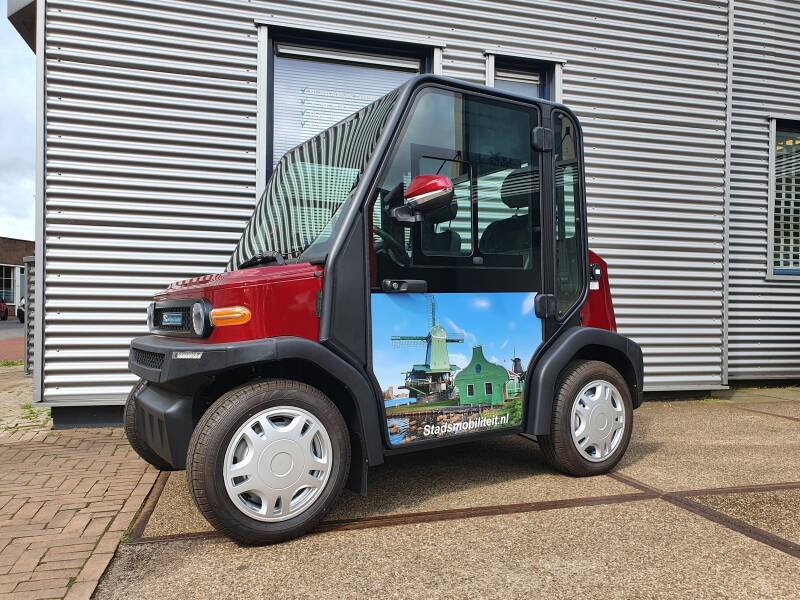Questions about urban mobility
Mobility and transport solutions are changing. This also changes a lot in legislation and possibilities of use. We would like to explain a number of new vehicles and applications to you. We would like to point out that no rights can be derived from the information.
Explanation of the different types of vehicles:
- Elektrische step (E-step): een voertuig type L1e met 2 wielen. Op dit moment alleen toegestaan op de openbare weg als er een zadel op zit. Brommer rijbewijs verplicht.
- Snorfiets (bromfiets): een voertuig type L1e met 2 wielen. Het is een brommer met een max. snelheid van 25 km/h. Soms helmplicht! Brommer rijbewijs verplicht
- Bromfiets: een vertuig type L1e met 2 wielen. Snelheid max. 45 km/h. Altijd helm verplicht. Brommer rijbewijs verplicht.
- Trike (bromfiets): een voertuig type L2e met 3 wielen. Snelheid max. 45 km/h . Bij een overdekte trike geen helm plicht wel een veiligheidsgordel. Brommer rijbewijs verplicht.
- Stadsauto (bromfiets): een voertuig type L6e met 4 wielen. Snelheid max. 45 km/h. Met dit voertuig mag je niet op de stoep parkeren. Brommer rijbewijs verplicht. Ook wel LEV genoemd Light Electric Vehicle.
- Stadsauto (auto): een voertuig type L7e met 4 wielen. Max. snelheid 50 of 80 km/h. Te besturen alleen met een autorijbewijs.
- Scootmobiel (minder validevoertuig/ innercity): een voertuig met 3,4 of 5 wielen. Mag op de stoep parkeren, eisen op rijksoverheid.nl/bijzonderevoertuigen. Vanaf 16 jaar geen rijbewijs nodig.
The advantages of electric transport:
Electric driving is better for the environment
Fully electric vehicles have no direct emissions of CO2 or exhaust gases. This means that electric vehicles are better for the environment.
Electric driving is cheaper
Electricity is cheaper than fossil fuels. This means that you can save a lot of money in the long term with electric driving.
Electric vehicles require less maintenance
There are far fewer moving parts in an electric motor and few wearing parts. The wear parts are mainly the brakes and tires on the vehicle.
Electric driving is quiet and comfortable
An electric motor makes almost no noise and also has no exhaust! Furthermore, all electric vehicles are automatic, so you do not have to change gears.
Important notes
You do not pay road tax for light electric vehicles (LEVs). An APK (general periodic inspection) is also not necessary. And there are fewer parking problems because the vehicles are more compact than most passenger cars. Electric vehicles have no CO2 emissions and are allowed to drive in all environmental zones.
The batteries in the vehicles are purchased (not rented) and delivered fully charged. Charging costs are much lower than refueling fossil fuels. Charging is possible with a normal 'home' socket.
Important note for charging:
If you use an extension cable for charging, pay attention to the thickness of the cable. You need a minimum thickness of 2.5 mm² per cable. The longer the extension cable, the greater the cable thickness must be. It is better not to use extension cables longer than 10 meters for the best charging capacity! As a result, the full voltage of 230 Volts arrives in the charger and you prevent overloading of the device.
Battery maintenance and charging instruction:
If the batteries are not used for a longer period of time, they should still be charged after a maximum of 30 days. Failure to follow these recommendations will reduce the battery capacity and invalidate the warranty.
Please only use the supplied charging cable. This can be connected to any Schuko socket with a 16A fused connection. The socket must be connected by a professional in accordance with NEN1010.
For the use of a connection to a 'charging station' type 2 or 'wall-box' an adapter cable with a type approval is required.




